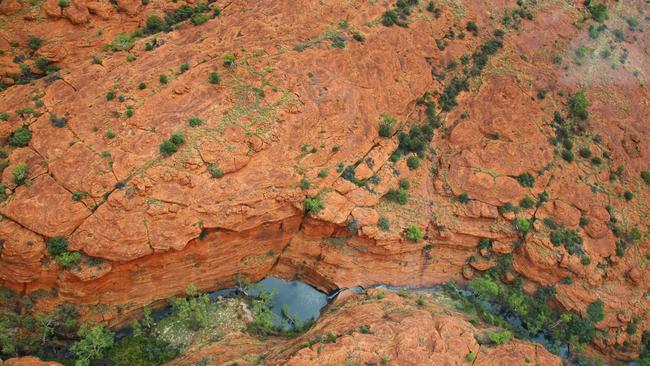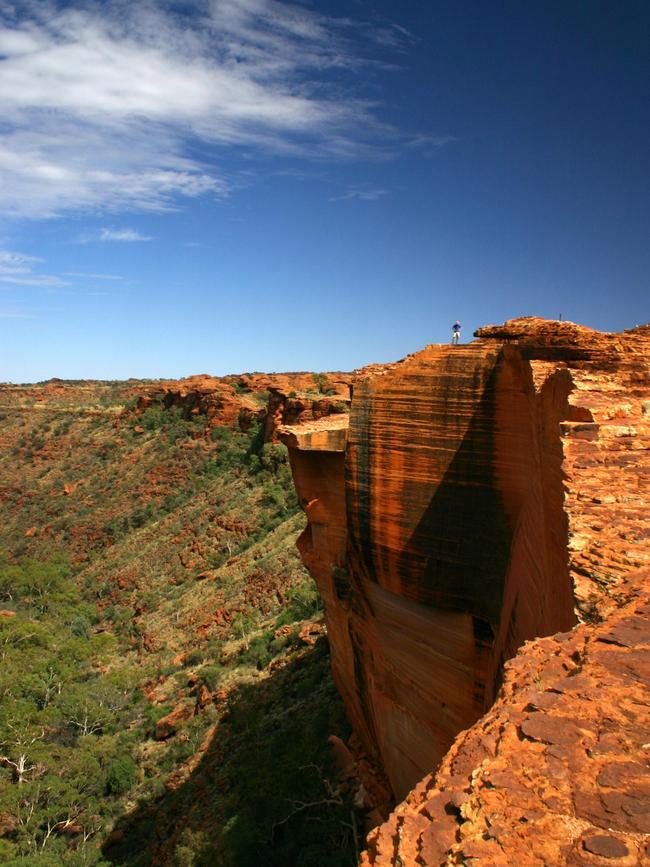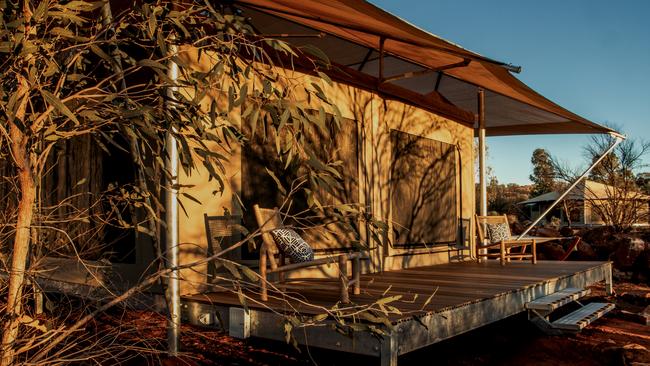Red earth dreaming
A trip to Central Australia reveals some of the secrets of this ancient land.

The helicopter banks sharply to the left and suddenly the outline in rock of a dingo and her suckling pups becomes clear in the vast red landscape below. Each of those ridges lined up in a row is one of the offspring, while the mother’s sprawling body is the ancient, worn George Gill Range topped by Carmichaels Crag. The pilot, Austin, speaks into the crackling headset explaining that the local indigenous people described the sight underneath us long before it could be seen from the air. Not for the first time I am struck by the synergy between the ancient and the modern that makes Kings Canyon and its surrounds in arid Central Australia, just 30 minutes by charter flight from Uluru, such a surprising and rewarding experience.
It’s my first flight in a helicopter and I couldn’t have chosen a better place to experience the joyous freedom of swooping low over the ground to capture a detail or quickly climbing to see the enormous sky meet the Earth at a far-off horizon. We are soaring across the range when the plateau comes to an abrupt end, with a sloping cliff marked by fallen boulders each the size of a 4WD. It’s thrilling to see the ground fall away while we hover above.
Our flight has already taken us over the Garden of Eden, tucked into a crevice of rocks where a precious pool of water allows lush plants, including remnant cycads, to survive. A disjointed string of diamond water pools sparkles along the extraordinarily regular grooves that cut into the sandstone range. It’s a landscape created by wind and water erosion. This was once a vast shallow sea, evidenced on the ground by the fossilised ripples of a once-sandy bottom and the tracks of a giant soft worm or millipede left in the rock now pushed half a kilometre above sea level.

This is not the land that time forgot; this is a place made by time: eons, eras, ages, millennia. Indulge in a little geology for a moment and wonder at the scale. The sandstone of the canyon was formed 440 million years ago, about the same time as life first appeared on land. This explains why there are few fossils of creatures found on that ancient sea bed.
About 300 million years ago the mountain range was formed. Tens of thousands of years ago the first people arrived. The Luritja people have lived in this area for at least 22,000 years. Back on the ground after my 15-minute flight, I am about to meet some of their descendants. There are three small indigenous communities in the Kings Canyon area, with as few as 10 residents at Wanmarra, where Peter Abbott and Christine Breaden live on their ancestors’ lands inside Watarrka National Park. The pair have been running their Karrke Aboriginal Cultural Experience and Tours for visitors for about four years and welcome 3000 people a year to their hands-on demonstrations.
Palya is the word of the hour, used often and enthusiastically. It means thank you but it also has lots of other meanings such as nice, or wonderful. Peter is a patient host, open to any and all questions about Aboriginal life and culture, while Christine demonstrates skills and cultural knowledge such as grinding seeds, extracting witchetty grubs from the favoured acacia tree roots (they taste much better, like popcorn, than eucalyptus-flavoured grubs) and bush medicine. Their aim is to preserve the heritage, including the fast-disappearing language, of the Luritja and Pertame people. And they are more than happy to show the grinding stones used to prepare mai, or food, by turning seeds into small bread cakes to be baked in a fire, the spears and boomerangs used to hunt wildlife and the paintings that depict the area and its people.

Some of the skills Peter and Christine show our small group look like they would be rarely used now when kangaroo tails, a favourite food, can be bought frozen from the Kings Canyon Resort general store, and wildlife is sparse, at least for the moment. To find roos now, hunters need to drive about 90km to the plains area.
Christine shows how to knock large (in this case sculpted) lizards on the head with a hard mulga-wood stick. Peter still makes traditional weapons using the old methods and tourists may touch only those that have not been used in ceremony. He points out there are no come-back boomerangs or didgeridoos in this part of the world.
Among the grinding rocks on display is a well-worn broken one that belonged to a woman who died. In keeping with tradition, her stone was shattered when she died as possessions are not passed on to descendants. And from mid-November until mid-January, the Karrke experience is closed because that’s when important ceremonies take place.
This is living heritage but also the hope of the future for the community. Peter’s sister Natasha says they would like to get more community members confident enough to talk to tourists and for the business to be entirely Aboriginal-owned and operated. If only the Taxation Office would recognise their remote location as a real address. They are still working on it.
It’s just half an hour’s drive from Karrke (the Aranda word for the western bowerbird) back to where I am staying at Kings Canyon Resort, and once again I am struck by the vast leaps in time that can be made in such a short distance. I go from standing among the fragrant, calming smoke of the emu bush that ended our experience, like the smoking ceremony at the close of an important corroboree, to collapsing into a cane swing chair on the veranda of my brand new glamping tent the size of a small luxury apartment. Kings Canyon Resort recently debuted six of these abodes, which mark a step up in the standard of accommodation for this area.

And the glamorous part of glamping is definitely catered for here. In my family tent there is a lounge area and a huge, comfortable bed with navy linen and plush throws. There is a dining area and bathroom with rain shower and flushing toilet — all the trappings of a hotel in a tent, topped off with aircon and a fridge. There’s even a kids’ bedroom and another small room that could be put to multiple uses. It’s an oh-so-comfortable way to revel in the red rock, the red dust and the red sky at sunset as the last light illuminates the escarpment, glowing like fire.
The tent is finished in natural, neutral colours and materials such as cane and wood, with canvas and the all-important fly netting to keep the elements at bay. I can feel the wind as it flaps at the tent and sways the swing seat on the veranda but the dust and the flies and the heat stay outside where they belong.

The view through the large front “windows” is of the canyon landscape, a dull iron red in the glare of daylight under the bright blue sky, framed by swaying eucalypts. A little trail marked out by rocks and garden lights guides me home in the evening, when torches are necessary to navigate to the restaurant and other facilities. The overwhelming darkness at night also allows you to see that other ancient spectacle here — the glorious evening sky with the Milky Way lighting a pathway across the great arc of star-studded blackness.
As I lie awake listening to the breeze in the desert oaks nearby, I rewind a day that began before 6am, getting ready to tackle the great Kings Canyon Rim Walk, a four-hour adventure in the cool morning that takes you to the height of the range and the pool at the Garden of Eden, followed by the helicopter tour and the Karrke experience.
I have climbed a great landmark, soared over an ancient landscape and heard the stories of its people. I have stood at the top of the canyon where you can look due west and know there is no human settlement until you hit Carnarvon on the West Australian coast 1850km away. I have heard the science behind the red iron colour of this world and seen its stories drawn in the soft dust with a stick, only to be erased with a brush of the hand. I have seen rocks that were once the size of houses but have been worn into giant beehive mounds.
I have seen tempting cycad fruit that made early explorers sick, poisonous bush tomatoes and spinifex grass that can be made into bread. I have walked down from the remote canyon rim to a car park filled with bustling tourist buses and a shelter where everyone had their head down over their phones using the free Wi-Fi.
Now I can hear something special. A whimpering builds to a cry and then a howl. A group of dingoes is walking through the campground. It is the season when dingo pups are born. I can’t see any of the pack but through the thin tent walls I can hear them crying to each other as they move closer and then fade away into the night.
Petra Rees was a guest of Kings Canyon Resort and Tourism NT.
-
IN THE KNOW
Kings Canyon Resort offers three glamping tents designed for couples, and three family tents. From $390 a tent a night, twin-share; children to age 12 free; buffet breakfast included.
Professional Helicopter Services provides a transfer from Ayers Rock Airport to Kings Canyon Resort.
Christine Breaden and Peter Abbott, of the Wanmarra Aboriginal Community, run the one-hour Karrke Aboriginal Cultural Tour; $65 a person.


To join the conversation, please log in. Don't have an account? Register
Join the conversation, you are commenting as Logout